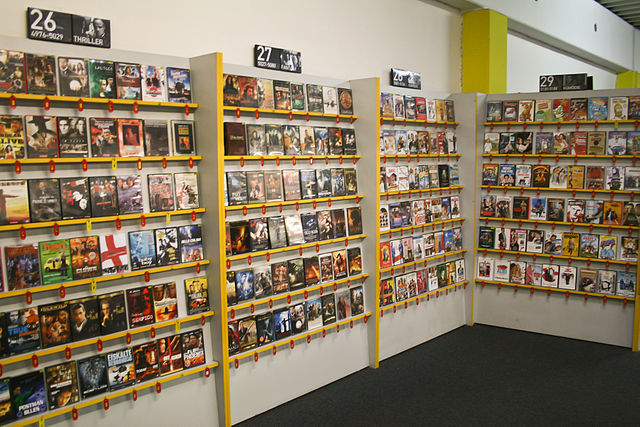The LaserDisc (LD) is a home video format and the first commercial optical disc storage medium, initially licensed, sold and marketed as MCA DiscoVision in the United States in 1978. Its diameter typically spans 30 cm (12 in). Unlike most optical-disc standards, LaserDisc is not fully digital, and instead requires the use of analog video signals.
A LaserDisc held
Used LaserDiscs for sale at a used book store in 2023. The used Laserdisc market as of 2020[update] remains supported by a "loyal following" of "thousands". In front is the release of Aladdin and the King of Thieves and the warning notice as the discs are not like vinyl records.
Constant Angular Velocity LaserDisc showing the NTSC field setup and individual scanlines. Each rotation has two such regions.
A top-loading, Magnavox-brand LaserDisc player with the lid open
Home video is recorded media sold or rented for home viewing. The term originates from the VHS and Betamax era, when the predominant medium was videotapes, but has carried over to optical disc formats such as DVD and Blu-ray. In a different usage, "home video" refers to amateur video recordings, also known as home movies. Another format LaserDisc is also a home video format released in 1978 which never caught on market due to high cost of the players and their inability to record TV programs unlike the VHS. The format gained interests from movie collectors.
Some home video users have a collection of prerecorded media, such as movies, on DVDs. DVDs are only one of a number of ways of viewing home video.
A feature film is viewed on a home screen.
Movie boxes on display at a video rental store
By the mid 2000s, home video purchasers moved away from videotapes, increasingly preferring DVDs. Pictured is a cart of used videotape movies on sale at a used-goods market in 2004.


![Used LaserDiscs for sale at a used book store in 2023. The used Laserdisc market as of 2020[update] remains supported by a "loyal following" of "thous](https://upload.wikimedia.org/wikipedia/commons/thumb/f/f3/Used_laserdiscs_2023.jpg/600px-Used_laserdiscs_2023.jpg)





